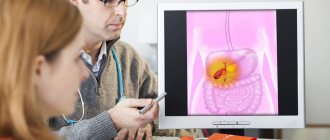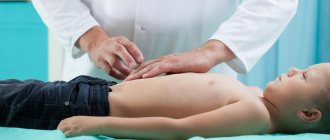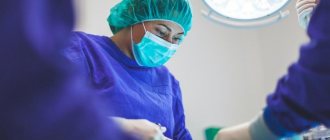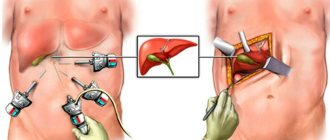Removing fibroids (benign tumors) is a complex operation, and after its completion you cannot simply return to normal life. The next stage is rehabilitation. There are several stages:
- Early postoperative: it begins immediately after the completion of the operation and ends when the patient leaves the hospital.
- Late post-operative: This rehabilitation period lasts approximately two months after discharge.
- Long-term: this recovery period begins two months after discharge and lasts until the patient is fully recovered, the exact timing depends on the patient’s condition.
Consequences and complications of the postoperative period
Any surgical intervention is stressful for the body. Its consequences depend on the age, weight, general health of the patient, methods and quality of treatment and other factors, but there are a number of the most common complications depending on the rehabilitation period.
Early
- Complications after anesthesia: a sharp rise or fall in temperature, constant temperature measurements, vomiting, tongue retraction, arrhythmia.
- Inflammatory processes: infection or suture dehiscence, swelling, redness, purulent discharge, peritonitis as a result of inflammation.
- Circulatory disorders: thrombosis, internal and external bleeding, hematomas, hematomas, etc.
- Painful sensations: any damage to tissue integrity is accompanied by a painful symptom. Rehabilitation after surgery to remove uterine fibroids allows you to minimize pain. Discomfort often occurs when urinating. This is considered normal, but still requires treatment.
- Disorders of urination and stool excretion, intestinal obstruction, etc. The impact of surgery affects metabolism and leads to various adverse consequences.
- Pneumonia, usually caused by prolonged bed rest.
Typically, these consequences and complications are characteristic of all surgical interventions, and not just for this particular disease.
Late
- Intestinal disorders.
- Hernias.
- Depression. The state of depression is caused by emotional exhaustion associated with an unpleasant diagnosis and subsequent treatment. Mood is affected by changes in lifestyle, thoughts about infertility, the presence of scars (they remain if abdominal surgery was performed, with laparoscopic surgery there are practically no traces), etc.
During the late period, the main healing processes are completed. Significant complications are rare.
Remote
- Recurrence of the disease: This is usually due to the fact that the doctor did not eliminate the cause of the tumor or did not take into account other factors, such as hormone levels.
- Menopause: Hormonal changes cause various reactions in the body, including the early onset of menopause.
- Osteoporosis: The disease and subsequent surgery negatively affect the body's calcium levels. Its deficiency leads to increased bone fragility.
- Diseases of the genitourinary organs: this may be infertility (many operations, for example, laparoscopy of uterine fibroids, allow you to preserve reproductive function, but a number of surgical interventions lead to infertility immediately or after some time), prolapse
- vagina, urinary incontinence, as well as diseases caused by non-compliance with personal hygiene rules, doctor’s recommendations and infection.
- Transformation of benign cells into malignant ones: special attention should be paid to the condition of the mammary glands, since they are most at risk.
- Depression and other psychological problems.
Complications can be determined not only at a doctor’s appointment. Increased body temperature, uncharacteristic discharge, burning sensation in the genital area and other changes are a reason to visit a specialist.
Recovery after surgery to remove uterine fibroids allows you to minimize the negative consequences.
Why do many gynecologists advise removing the uterus for fibroids?
The main reason for such a long dominance of therapeutic radicalism in the treatment of uterine fibroids is that for too long uterine fibroids have been considered, although benign, to be a tumor process, and the tumor, as the canons of surgery say, must be removed. Indeed, there is a list of organs without which a person can more or less exist. And from the point of view of many gynecologists, the uterus is almost in first place on this list.
For some reason, it is believed that having realized her reproductive function, a woman can part with the uterus completely painlessly, that is, a unique monofunctional relationship has been developed towards this organ. Wrong attitude. At the same time, it is quite obvious that there are no unnecessary organs in the body, and the uterus, in addition to the reproductive function, also has others, some of which are clear to us, and some of which are still not fully understood. To simplify, we can say that, being integrated into the whole organism, the uterus maintains a natural physiological balance.
A person can exist without one kidney, a lung, or part of the intestines, but everyone understands that this existence is no longer a completely full-fledged person, so why is a woman without a uterus considered healthy in the minds of a number of doctors? Indeed, it has been known for many years that removal of the uterus entails the development of the so-called posthysterectomy syndrome - a symptom complex of disorders of the endocrine, nervous, cardiovascular and other systems that occurs after removal of the uterus and is associated with this removal through a direct cause-and-effect relationship.
A special place is occupied by psychological consequences - the presence of a uterus is a subconscious element of femininity, involvement in the female gender. The presence of a uterus gives a woman constant inner confidence that she can give birth to a child. And even if she definitely does not want to have more children, permanent deprivation of this function may be emotionally unacceptable for her.
Some studies that examine the functions of the uterus show interesting results. For example, in 2022, scientists from Arizona State University (USA) conducted an experiment on rats: some animals had their ovaries removed, others had their uterus, while others were not operated on, and their uterus and ovaries continued to function. Animals whose uterus were removed were less able to navigate mazes.
However, other studies show that women who have a hysterectomy have an increased risk of developing dementia. The uterus somehow influences the functioning of the nervous system, and these relationships remain to be studied.
In addition, during the experiment it turned out that the hormonal levels in the body changed in rats that had undergone hysterectomy. And this, as we know, can potentially create a number of health risks. This suggests that the uterus is needed not only during pregnancy. When a woman is not pregnant, the uterus does not “sleep” and is not at rest. It performs some functions that have yet to be understood in more detail.
The results of such studies provide a strong argument against hysterectomy in cases where there is no truly justified indication for it.
How to speed up the recovery process after removal of uterine fibroids
When a woman undergoes fibroid removal, recovery from even minimally invasive surgery can last up to 3 months. A number of procedures allow you to speed up this process, make it more comfortable and quickly return to your normal lifestyle; it is also important to follow the basic recommendations of a specialist. As a rule, the doctor voices them to each patient personally, but there are a number of universal tips:
- Wear a postoperative bandage: it provides the condition necessary to maintain the desired position of the internal organs, which helps prevent vaginal prolapse, etc.
- Observe contraception: pregnancy is not allowed for a year, but this period may last longer, depending on individual health indicators. It is optimal if contraceptive methods are selected by a doctor.
- Refuse thermal procedures: visiting a solarium, bathhouse, beach, seaside holidays, etc. is prohibited.
- Eat right: foods should be easy to digest. You should not eat fixing foods; you should give preference to soups, cereals, etc. After discharge from the hospital, you can add fruits, raw or baked vegetables, fish, and lean meat to your diet. It is recommended to completely avoid fatty, fried, viscous foods, carbohydrates, alcoholic beverages and coffee.
- Maintain a daily routine: it is worth including full sleep, daily walks, moderate physical activity (morning exercises, exercise therapy).
- Get rid of bad habits: smoking, stress, lack of sleep, etc. are prohibited.
And, of course, do not forget about regular examination by a doctor, even if there are no signs of complications.
Recovery after removal of uterine fibroids: methods
- Drug therapy.
Removal of fibroids does not leave its mark on the body. Depending on the patient’s condition, the doctor selects medications. Usually these are drugs that relieve pain, strengthen the immune system, help replenish blood loss, as well as drugs to prevent blood clots. To restore hormonal levels and as a means of preventing relapse, the doctor individually selects hormonal drugs. - Physiotherapy.
A number of procedures, for example, SMT, lymphatic drainage massage, ultrasound and magnetic therapy, improve blood circulation and accelerate tissue regeneration processes, help avoid problems associated with changes in hormonal levels, early menopause, and are a means of preventing adhesions, swelling of the lower extremities, urinary disorders, etc. - Physiotherapy.
Moderate physical activity under the supervision of a specialist can strengthen the immune system and restore muscle tone. The optimal sports are gymnastics and regular walks, but any water sports will have to be abandoned. Kegel exercises help relieve urinary incontinence. Breathing exercises help avoid adhesions and speed up recovery. - Psychotherapy.
Women often experience depression caused by infertility after surgery to remove uterine fibroids. Rehabilitation in this case is impossible without psychotherapy. The doctor helps restore your emotional state and overcome depression.
Opportunity to become a mother after uterine amputation
Quite often, the cause of uterine amputation is inaccurate diagnosis, and, as a result, incorrectly prescribed therapy, which leads to aggravation of the pathological process in the uterus. The lack of modern diagnostic equipment and the insufficient level of knowledge and experience of the doctor can lead to an irreparable error, an incorrect diagnosis and the appointment of removal of the main female reproductive organ. As a result, the woman becomes unable to become pregnant and bear a child.
If such a disaster has happened to you, we will help you achieve the truth in court. Our lawyers have sufficient experience to prove medical malpractice. We are also ready to provide the services of a surrogate mother, with the help of which you can find the happiness of motherhood, because life continues after amputation of the uterus. Fill out the application on our website and we will definitely contact you!
General rules for recovery after myomectomy
Rehabilitation after removal of uterine fibroids is associated with a number of limitations. For example, at first, bed rest is indicated: you cannot walk or stand for a long time. Thermal procedures and sunbathing are prohibited. You should also not be in the cold: hypothermia has a negative effect on the body. It is contraindicated to lift weights (more than 2 kg at first and more than 10 kg after discharge), overexertion (this includes daily household chores and physical exercise). You should abstain from sexual activity for about two months after surgery; pregnancy is not allowed for about a year. It is important to eliminate stress and emotional overload. For 1-2 months you should not use tampons, only pads; until the stitches are completely healed, you should not go to the pool or swim in bodies of water. If you have constipation, you should consult a doctor or solve the problem yourself. It is not recommended to use synthetic or too tight underwear; clothing should not squeeze or rub the skin.
How does the operation proceed?
Women who decide to use the surgical treatment option need to discuss with their doctor all the nuances of the procedure and clarify in advance whether the uterus with appendages, ovaries, and other organs will be removed or only a specified area will be affected. The consequences of removing the uterus, the method of performing the operation and the nature of the incision depend on this. The following types of surgery to remove the uterus are distinguished:
- Abdominal intervention, which is performed in most cases. The doctor makes an incision about 20 cm long in the abdomen. The procedure is performed under general anesthesia.
- Extraction through the vagina. During the operation, an incision is made in the cervix and the organ is removed through the vagina. This type of intervention is contraindicated in the presence of neoplasms, cysts and other obstacles to the procedure.
- Laparoscopy is a method of removal in which small incisions are made in the abdomen. It has certain contraindications, which the attending physician must warn about.
What not to do after abdominal surgery to remove fibroids
Patients are interested in what can and cannot be done after surgery to remove uterine fibroids. Rehabilitation usually consists of the procedures and recommendations described above. The main thing is to listen to your doctor and take care of your health. The early period is considered the most important: a number of restrictions are caused by the fact that the wound has not yet healed completely and there is a risk that the stitches will come apart. For this reason, you should not overexert yourself; loads are allowed, but they must be moderate. It is recommended to take a shower instead of a bath to avoid infection.
How long does it take to recover after removal of uterine fibroids?
It is difficult to determine in advance how long rehabilitation will last, since this parameter depends on many conditions: from the patient’s age to the treatment method. For example, the early postoperative period after hysterectomy is 10-14 days, and recovery after laparoscopy for uterine fibroids usually does not exceed 5 days. The late and late periods also differ from each other in duration.
In addition to the type of intervention, the period determines the age, general health of the woman and the quality of the selected treatment. As a rule, complete recovery in the absence of serious complications takes about a year.
Remove the uterus and save the ovaries?
Here it is necessary to point out another deceit of gynecologists who suggest removing the uterus as soon as possible. They often emphasize the fact that after the operation the ovaries will remain and continue to function fully; only the uterus is removed - “no longer a necessary sac for bearing children, filled with knots.” It is not true! In the process of removing the uterus, in any case, the blood supply to the ovaries is disrupted, since one of the important routes of blood supply to the ovary, a branch of the uterine artery, is crossed.
After the operation, the ovaries try to compensate for the missing blood supply, but in most cases this does not work, and in the absence of blood supply, degenerative processes begin in the ovary, leading to a decrease in hormone production.
In general, one can continue ad infinitum to argue in favor of preserving the uterus, but I would like to express the main idea: the doctor does not have the right to decide for the patient which organs she needs, and which ones she, in principle, can do without, guided only by considerations of her own benefit and misleading her.
The doctor’s lack of knowledge about all currently available methods of treating the disease is his great disadvantage, from which his patients suffer; concealment or deliberately false informing the patient about alternative methods of treatment should be considered nothing less than a crime.
Remember that in modern conditions, in the vast majority of cases, uterine fibroids can be treated without removing the uterus. Only the presence of serious concomitant gynecological diseases can justify removal of the uterus; in all other cases, there is no need to remove this organ.
Removal of fibroids: rehabilitation after surgery in
The health, well-being and mood of our patients is our main value. That is why we provide them with all the conditions to achieve the desired results. Our center employs professional doctors who regularly improve their skills. We adhere to an individual multidisciplinary approach: all procedures are selected depending on the health indicators of each individual patient; not only rehabilitation specialists, but also doctors of other subspecialties participate in decision-making. This is the only way we can choose the optimal course of procedures. Our center is equipped with modern simulators and devices that have proven their effectiveness. The friendly atmosphere and cozy rooms make you feel comfortable. Good mood and positive attitude play a big role in recovery, so we have created a pleasant microclimate, and professional psychotherapists with extensive practical experience work with patients.











